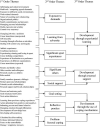A Multi-Study Exploration of Factors That Optimize Hardiness in Sport Coaches and the Role of Reflective Practice in Facilitating Hardy Attitudes
- PMID: 32903676
- PMCID: PMC7438814
- DOI: 10.3389/fpsyg.2020.01823
A Multi-Study Exploration of Factors That Optimize Hardiness in Sport Coaches and the Role of Reflective Practice in Facilitating Hardy Attitudes
Abstract
Hardiness has been identified as a key personal characteristic that may moderate the ill-effects of stress on health and performance. However, little is known about how hardiness might be developed, particularly in sport coaches. To systematically address this gap, we present two linked studies. First, interviews were conducted with pre-determined high-hardy, elite coaches (n = 13) to explore how they had developed their hardy dispositions through the associated attitudinal sub-components of control, commitment, and challenge. Utilizing thematic analysis, we identified that hardiness was developed through experiential learning, external support, and the use of specific coping mechanisms. Key to all of these themes was the concept of reflective practice, which was thought to facilitate more meaningful learning from the participants' experiences and, subsequently, enhance the self-awareness and insight required to augment hardiness and its sub-components. To investigate further the potential relationship between coaches' reflective practices and their level of hardiness, we conducted a follow-up study. Specifically, a sample of 402 sports coaches completed the Dispositional Resilience Scale-15, the Self-Reflection and Insight Scale, and the Questionnaire for Reflective Thinking. Using latent profile analysis (LPA), we clustered participants into groups based on their reflective profiles (e.g., type of engagement, level of reflective thinking). We then examined differences in hardiness between the five latent sub-groups using multinomial regression. Findings revealed that the sub-group of highly engaged, intentionally critical reflective thinkers reported significantly higher levels of all three hardiness sub-components than all other sub-groups; these effect sizes were typically moderate-to-large in magnitude (standardized mean differences = -1.50 to -0.10). Conversely, the profile of highly disengaged, non-reflective, habitual actors reported the lowest level of all three dimensions. Collectively, our findings offer novel insights into the potential factors that may influence a coaches' level of hardiness. We provide particular support for the importance of reflective practice as a meta-cognitive strategy that helps coaches to develop hardy dispositions through augmenting its attitudinal sub-components. Consequently, our research makes a significant contribution by providing a comprehensive insight into how we might better train and support coaches to demonstrate the adaptive qualities required to thrive in demanding situations.
Keywords: experiential learning; hardiness; latent profile analysis; mixed-methods; reflective practice; sport coaching.
Copyright © 2020 Cropley, Baldock, Hanton, Gucciardi, McKay, Neil and Williams.
Figures



Similar articles
-
Reflections on Reflection: Clarifying and Promoting Use in Experienced Coaches.Front Psychol. 2022 May 4;13:867720. doi: 10.3389/fpsyg.2022.867720. eCollection 2022. Front Psychol. 2022. PMID: 35602681 Free PMC article.
-
A Coach Development Program: A Guided Online Reflective Practice Intervention Study.J Sports Sci. 2022 May;40(9):1042-1054. doi: 10.1080/02640414.2022.2045795. Epub 2022 Mar 17. J Sports Sci. 2022. PMID: 35297307
-
A survey of "mental hardiness" and "mental toughness" in professional male football players.Chiropr Man Therap. 2014 Apr 15;22:17. doi: 10.1186/2045-709X-22-17. eCollection 2014. Chiropr Man Therap. 2014. PMID: 24735867 Free PMC article.
-
Social support, network, and relationships among coaches in different sports: a systematic review.Front Psychol. 2024 Sep 24;15:1301978. doi: 10.3389/fpsyg.2024.1301978. eCollection 2024. Front Psychol. 2024. PMID: 39380751 Free PMC article.
-
Conceptual framework of coaches' decision-making in conventional sports.Front Psychol. 2025 Jan 9;15:1498186. doi: 10.3389/fpsyg.2024.1498186. eCollection 2024. Front Psychol. 2025. PMID: 39886368 Free PMC article. Review.
Cited by
-
Coaching the Coach to Reduce Burnout: Commentary on Do Resident Coaching Programs Benefit Their Coaches? Impact of a Professional Development Coaching Program on the Coaches.World J Surg. 2023 Jul;47(7):1617-1618. doi: 10.1007/s00268-023-07015-3. Epub 2023 Apr 15. World J Surg. 2023. PMID: 37060365 No abstract available.
References
-
- Anguera M. T., Blanco-Villaseñor A., Losada J., Sánchez-Algarra P., Onwuegbuzie A. (2018). Revisiting the difference between mixed methods and multimethods: Is it all in the name? Qual. Quant. 52 2757–2770. 10.1007/s11135-018-0700-2 - DOI
-
- Asparouhov T., Muthén B. (2018). Auxiliary Variables in Mixture Modeling: Using the BCH Method in Mplus to Estimate a Distal Outcome Model and an Arbitrary Secondary Model. Mplus Web Notes, 21. Avaialable at: https://www.statmodel.com/examples/webnotes/webnote21.pdf (accessed January 30, 2020).
-
- Bartone P. (1995). A short hardiness scale. Paper Presented at the American Psychological Society Annual Convention, New York, NY.
-
- Bartone P. (2012). Social and organizational influences on psychological hardiness: how leaders can increase stress resilience. Secur. Inform. 1:21 10.1186/2190-8532-121 - DOI
-
- Bartone P., Barry C. (2011). “Leading for resilience in high risk occupations,” in Working in High Risk Environments, ed. Paton D. (Springfield, IL: C. Thomas; ), 125–144.
LinkOut - more resources
Full Text Sources
Miscellaneous

